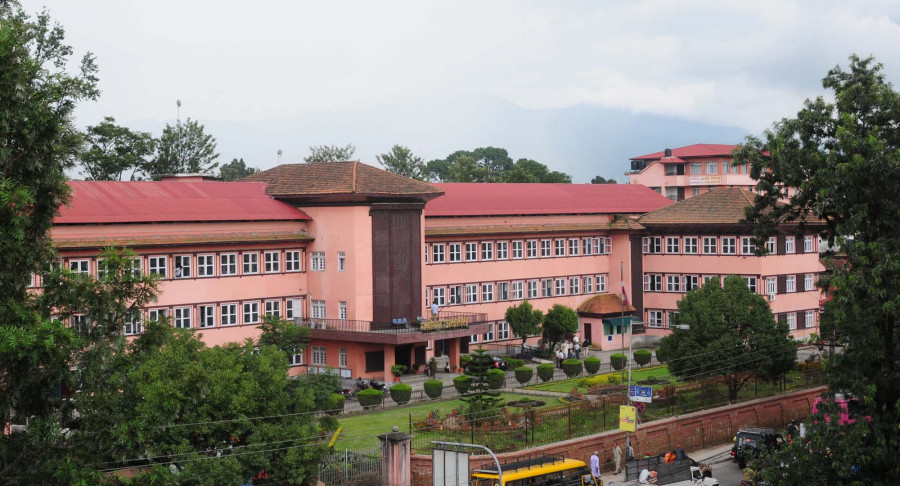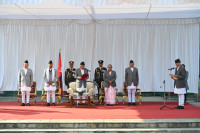National
With hearing on House dissolution over, the justices will now study legal briefs and discuss case before verdict
More than 100 lawyers, including amicus curiae members, spoke on the legality of Oli’s move. Arguments on both sides were weak and repetitive and waste of time, analysts say.
Binod Ghimire
After nearly two months of hearing on the writ petitions against the December 20 dissolution of the House of Representatives, lawyers finished putting forth their views on Friday. The last of the five members of the amicus curiae, Gita Pathak Sangraula, rounded up the arguments.
With the conclusion of the hearing, Chief Justice Cholendra Shumsher Rana, who is heading the Constitutional Bench hearing the writs, asked the plaintiffs and lawyers representing them and the defendants’ lawyers to present their legal briefs to the court by Monday.
“The process for the final verdict will commence on Tuesday which could take a few days,” Chief Justice Rana said on conclusion of the hearing.
According to officials at the Supreme Court, the five-member Constitutional Bench will study the legal briefs which will be followed by a consultation among the justices on the final verdict.
“It will take at least a few days for the study and consultations,” Kishor Poudel, a communication expert at the Supreme Court, told the Post.
More than one hundred advocates had put forth their arguments before the bench from the two sides although the number of those who wanted to take part in the hearing was over 200.
The hearing on the writs began on December 23, three days after President Bidya Devi Bhandari dissolved the House of Representatives on the recommendation of Prime Minister KP Sharma Oli. A single bench of Rana through the first hearing had decided to send 12 of the 13 writ petitions against the dissolution to the Constitutional Bench claiming the matter required serious constitutional interpretation.
The Constitutional Bench formed on December 25, after listening to the opening remarks of a handful of lawyers, directed Bhandari and Oli to present written justifications for their move to dissolve the House. The bench also requested the Nepal Bar Association and the Supreme Court Bar to recommend three and two senior advocates respectively for the amicus curiae.
The hearing began on January 15.
After the lawyers representing the plaintiffs and defendants presented their arguments for and against the House dissolution, the senior advocates in the amicus curiae started their arguments on Monday, concluding them on Friday.
Commenting on the court proceedings, constitutional experts said there was clearly a lack of coordination among the advocates from both sides.
“The arguments from both sides were weak,” said Bipin Adhikari, former dean at the Kathmandu University School of Law. “There was room to contest their arguments.”
Advocates representing the plaintiffs repeated the same argument that the prime minister’s move was unconstitutional without presenting strong arguments based on the constitution explaining why, according to Adhikari.
“They failed to clearly define the reasons to prove their claim that the dissolution was unconstitutional,” he said.
More than 60 advocates on behalf of the plaintiffs presented their arguments for 15 days claiming that Oli’s move to dissolve the House was a breach of the Constitution of Nepal. They said the House of Representatives is dissolved as per Article 76 (7) of the statute when there is a hung parliament and there is no possibility to form a government.
The move to dissolve the House was defended by the Office of the Attorney General and around three dozen private lawyers. Attorney General Agni Kharel on February 1 started the defence. He, however, failed to provide concrete constitutional grounds for doing so and instead continued to offer political reasons for the act, in line with the written clarification Prime Minister Oli had furnished to the court.
“The defendants’ presentation was even weaker as there were no articles from the constitution they could cite to prove that Oli’s move was constitutional,” said Adhikari.
Kharel maintained that House dissolution is a prime minister’s prerogative but stopped short of providing the constitutional provisions that vested Oli with the power. A majority of the lawyers who stood in defence of the House dissolution repeated the argument saying it was a political decision and inherent authority of the prime minister in a parliamentary democracy.
“Rather than standing on constitutional provisions, the lawyers tried to justify the dissolution saying that it is the prime minister’s prerogative in the parliamentary system to dissolve the lower house. But the prime minister's prerogative to dissolve the House, which is a feature of a Westminster system, was deliberately withdrawn in our constitution,” said Adhikari, commenting on the defendants’ defence. “The claim from defenders that Oli dissolved the House using the prerogative doesn’t hold water.”
After the two sides finished their arguments it was the turn of the amicus curiae.
Of the five friends of court, Satish Krishna Kharel, Purna Man Shakya and Pathak categorically said there are no constitutional grounds for Oli to dissolve the House while Bijay Kant Mainali defended the move arguing that the prime minister, in a parliamentary democracy, has an inherent authority for the dissolution.
Badri Bahadur Karki, on the other hand, wavered arguing that several ambiguities in the Constitution of Nepal regarding the House dissolution which needs to be interpreted by the court rather than saying clearly whether a prime minister can dissolve the House or not. He, however, said as Oli’s move was guided by a mala fide intention, and therefore, it was unconstitutional.
According to Adhikari, the members of the amicus curiae could clearly present their arguments explaining the constitutional provisions and legislative intent.
However, there was a repetition from the lawyers who pleaded on the side of the plaintiffs and the defendants, Adhikari said.
“They only killed the crucial time of the court. The bench shouldn’t have allowed that,” he said.
Before the Constitutional Bench began the hearing on January 15, Justice Sapana Pradhan Malla on January 13 replaced Hari Krishna Karki after he decided to recuse himself from the hearing on the grounds that he was once Oli’s counsel in the capacity of the attorney general. Justices Anil Kumar Sinha, Bishowambhar Prasad Shrestha and Tej Bahadur KC are other members of the bench.
Raju Prasad Chapagain, chairperson of the Constitutional Lawyers’ Forum, said the quality of a hearing also depends on the bench.
“Along with the lawyers, the bench is also responsible for the low quality of the hearing,” he told the Post. “Despite the issue having such huge implications, the overall hearing was superficial.”
The resolution of the most important political crisis in the country since the promulgation of the new constitution in 2015 will now be discussed by the five Supreme Court justices before the Constitutional Bench gives a verdict.
“It is difficult to specify the exact date for the verdict,” said Poudel, the communication expert.




 10.12°C Kathmandu
10.12°C Kathmandu















